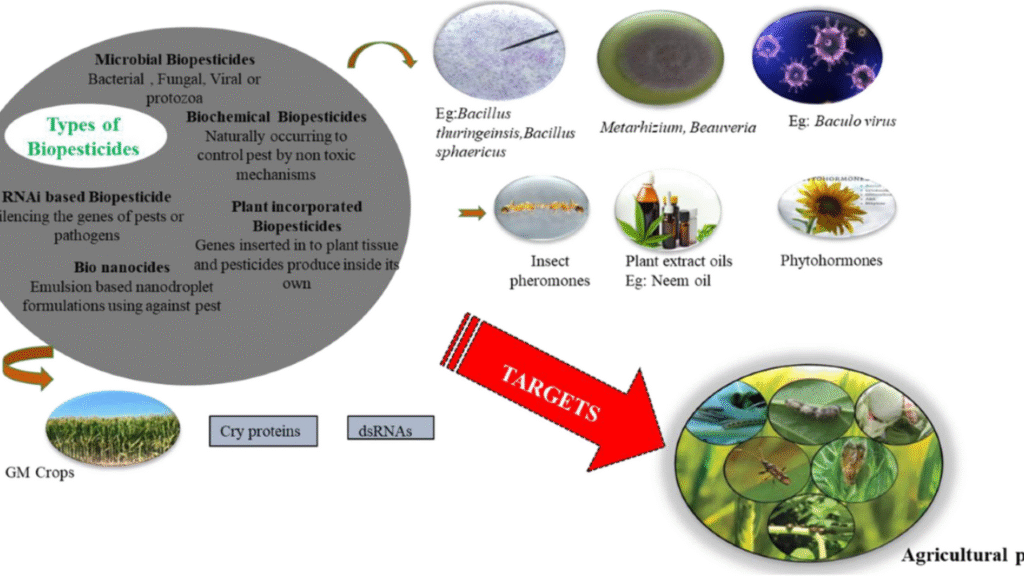
In an era of rising environmental awareness and demand for sustainable agriculture, plant-based biopesticides are transforming pest management. Derived from botanical sources, these natural pesticides provide an effective, eco-friendly alternative to synthetic chemicals. They target a wide range of pests while preserving beneficial organisms and soil health. But how do these plant-derived solutions actually work? Let’s dive into the mechanisms, examples, and real-world application of plant-based biopesticides.
Overview Table: Key Mechanisms of Plant-Based Biopesticides
| Mechanism | Description | Example Plant | Target Pest Type | Mode of Application | Benefit |
|---|---|---|---|---|---|
| Neurotoxic Disruption | Interferes with pest nervous system | Derris (Rotenone) | Aphids, beetles | Spray/extract | Rapid knockdown effect |
| Feeding Deterrence | Discourages insects from feeding | Neem (Azadirachtin) | Grasshoppers, caterpillars | Foliar application | Prevents crop damage |
| Growth Inhibition | Blocks metamorphosis or reproduction | Sweet Flag (Acorus calamus) | Mosquito larvae, moths | Soil/foliar spray | Reduces pest population |
| Respiratory Disruption | Suffocates pests or impairs respiration | Garlic (Allicin) | Thrips, mites | Volatile extract/spray | Broad-spectrum activity |
| Oviposition Repellence | Prevents insects from laying eggs on plants | Basil (Ocimum basilicum) | Leaf miners, flies | Oil/spray | Reduces future infestation |
| Fungal Symbiosis Support | Boosts plant’s natural antifungal resistance | Turmeric (Curcuma longa) | Soil-borne pests, nematodes | Soil drench | Enhances plant immunity |
What Are Plant-Based Biopesticides?
Plant-based biopesticides are naturally occurring substances derived from herbs, roots, seeds, flowers, or essential oils that deter, kill, or disrupt pests. Unlike synthetic chemicals, they are biodegradable, less likely to cause resistance, and safer for humans and pollinators.
They fall into various categories based on their action:
- Insecticides
- Repellents
- Antifeedants
- Fumigants
- Ovicides (egg killers)
1. Neurotoxic Disruption – Targeting Pest Nerve Systems
Certain plants contain compounds that directly interfere with the nervous systems of pests. A prime example is rotenone, extracted from plants like Derris spp. and Lonchocarpus spp.
How it Works:
- Blocks mitochondrial electron transport
- Causes paralysis and death in insects
Use Case:
- Rotenone-based sprays for aphids, leaf beetles, and fire ants
Limitation:
- Non-specific, should be applied with care to protect beneficial insects
2. Feeding Deterrents – Making Plants Unappetizing
Plants like Neem (Azadirachta indica) produce bio-compounds (e.g., azadirachtin) that interfere with insect appetite and digestion.
How it Works:
- Prevents pest larvae from feeding
- Alters hormonal balance disrupting molting
Common Targets:
- Caterpillars, locusts, and whiteflies
Advantage:
- Selective toxicity with long-term protection
3. Growth Regulators – Stunting Pest Life Cycles
Some plant-derived biopesticides act as insect growth regulators (IGRs). These interfere with hormonal signals necessary for molting, pupation, and reproduction.
Example:
- Sweet Flag (Acorus calamus) contains asarone, which inhibits development in mosquito larvae and moths.
Key Effects:
- Reduces fertility
- Prevents larvae from maturing
Usage:
- Seed treatment, soil amendments, or foliar sprays
4. Respiratory Disruption – Suffocating Pests Naturally
Volatile oils from plants like Garlic and Eucalyptus release sulfur-containing compounds or phenolics that disrupt respiratory function in insects and mites.
Mechanism:
- Penetrates cuticle and affects oxygen intake
- Triggers dehydration and suffocation
Best for:
- Soft-bodied pests like thrips, mites, aphids
5. Oviposition Deterrents – Stop Infestation at the Source
Many essential oils have a strong smell or chemical profile that repels female insects from laying eggs.
Example:
- Basil oil contains linalool and methyl chavicol, which deter flies and moths from laying eggs on plants.
Practical Application:
- Sprays or companion planting in pest-prone areas
6. Symbiotic Support – Strengthening Plant Defense
Some botanicals enhance the plant’s own ability to resist pests by stimulating natural microbial defenses or inhibiting pathogenic fungi and nematodes.
Notable Example:
- Turmeric’s curcumin enhances resistance to soil-borne nematodes and fungi, helping roots repel invaders.
Comparative Table: Selected Plant-Based Biopesticides
| Plant Source | Active Component | Pest Type Controlled | Application Method |
|---|---|---|---|
| Neem | Azadirachtin | Whiteflies, aphids | Foliar spray |
| Garlic | Allicin | Thrips, mites | Spray or soil drench |
| Sweet Flag | Asarone | Mosquito larvae, moths | Water extract, seed soak |
| Basil | Linalool, methyl chavicol | Flies, beetles | Oil spray, intercropping |
| Eucalyptus | Cineole | Leafhoppers, mites | Vapor spray, fumigation |
Advantages of Plant-Based Biopesticides
- Eco-Friendly: Biodegradable and safe for soil and water ecosystems
- Resistance Management: Slows development of resistant pest populations
- Target Specificity: Minimal effect on beneficial organisms like bees and predators
- Compatibility: Can be used in integrated pest management (IPM) systems
- Cost-Effective for Small Farmers: Many ingredients can be homegrown
Challenges in Adoption
- Shorter Residual Effect: Requires more frequent applications than chemicals
- Standardization Issues: Variable efficacy due to environmental conditions and plant variability
- Shelf Life Concerns: Some extracts degrade quickly if not stored properly
Conclusion
Plant-based biopesticides represent a revolutionary tool for sustainable agriculture. By mimicking nature’s own pest control strategies, these botanical solutions provide a safer, environmentally responsible alternative to chemical pesticides. As technology and research improve extraction, formulation, and application methods, the future of pest management is poised to become increasingly green—and incredibly effective.
FAQs
Q1: Are plant-based biopesticides safe for pollinators like bees?
Yes, most botanical biopesticides are selective and pose little to no harm to pollinators.
Q2: Can farmers make biopesticides at home?
Many simple formulations using garlic, neem, or turmeric can be prepared and applied on small farms.
Q3: How long do botanical biopesticides remain effective after application?
Effectiveness usually lasts 5–10 days, depending on environmental conditions and pest pressure.

